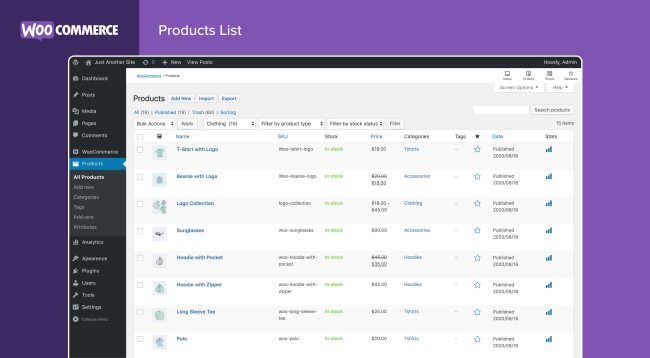- How to choose an engine for developing an online store?
- Platform popularity
- CMS age
- Convenience of the admin panel
- Availability of modules and plugins
- Quantity and cost of templates
- Technical support and knowledge base
- Integration capabilities
- Cost of use
- Readiness for SEO promotion
- What features should an eCommerce engine support?
- Which platform is better to choose for an online store?
- Boxed
- Handwritten
- Constructors
- Cloud (SaaS)
- Rating of free platforms for creating an online store
- Opencart
- WooCommerce
- Joomla!
- Prestashop
- TOP of the best paid CMS for Ecommerce
- Shopify
- Horoshop
- BigCommerce
- Ecwid
- Magento
- Squarespace
CMS is the main tool for managing the content of an online store. It is software and a set of tools that allow you to create and moderate website content, change the design and ensure the safety of data.
There are many systems for different purposes, so many entrepreneurs are often faced with the question of which platform is best to choose for an online store.
Some of them specialize in specific types of sites: online stores, information portals or landing pages, and some are universal. In this review of the best CMS for an online store, we will focus on the most popular engine options specifically for eCommerce.
How many calls and sales will I get by ordering contextual advertising from you?
I need to calculate the conversion of my website Describe
the task
in the application
Calculate potential ad revenue Google
contextual advertising calculator
How to choose an engine for developing an online store?
The question of which engine to choose for creating an online store is very important at the initial stage. Most people immediately make the mistake of launching the demo version and starting to study it chaotically. This approach is ineffective, so the choice should be approached step by step, taking into account all the main points.
Platform popularity
It is determined by the convenience and capabilities of the engine. Pay attention to the number and quality of modules, the availability of templates and the number of specialized programmers with extensive relevant experience.
Popularity also determines how easy it will be to find a web developer to make edits and customize functionality. This will make it possible to quickly respond to problems and receive timely security updates, as well as many high-quality extensions.
For less common IT products, it will be difficult to find a specialist, and dealing with errors that arise on the site or solving complex development problems can be very problematic.
CMS age
Good and reliable IT products are developed and perfected over a minimum of 5 years. At the same time, new solutions contain many bugs and have weak synchronization potential with third-party services.
Many years of uninterrupted operation of the system means reliability and stability, as well as processes that have been tested over the years. Such CMSs have fewer errors and vulnerabilities. On the other hand, new companies can offer fresh, innovative solutions and a more modern approach.
Convenience of the admin panel
Not only you as a manager will have to work in the admin panel, but also your subordinates. A clear interface, variable panel design and simple maintenance are the key criteria at the selection stage.
Employees should be able to easily administer orders from a computer, tablet or phone, and training should take a minimum of time. In addition, a convenient admin panel saves working time and simplifies business processes.
Availability of modules and plugins
The structure of the basic website administration panel includes certain components: product catalog, filters, categories, blog, news, analytics, menu, etc. This is enough to launch a store at the start, but in the future it may be necessary to expand the functionality.
If the project is just starting, it is better not to overpay for unnecessary functions, but if there are plans for further scaling of the business, it is better to immediately take into account the subsequent increase in potential.
Also pay attention to the interaction of plugins with each other and with the kernel. If modules are not updated regularly, there is a high risk that they will stop working when the system is updated.
Quantity and cost of templates
They define the navigation, text and image styles, and the layout and size of blocks on a website. Therefore, it is worth paying attention to the quantity and quality of available themes for a specific CMS.
The number of developers also plays a role here – if the platform is popular, it will be easy to find a layout designer, a programmer for it, to create a unique brand design directly for your needs.
Technical support and knowledge base
It is worth paying attention to the availability of professionals to eliminate possible problems. It is difficult to find a qualified programmer for rare IT products, while many specialists work with popular ones. The higher their qualifications, the more effectively business problems will be solved.
Thematic forums, cases of large web studios, as well as the number of freelancers on the network will help you check the level of feedback. Pay special attention to the availability of a support service for beginners who have no experience in administering web resources.
Integration capabilities
An equally important criterion is the connection with other services: marketplaces, CRM, ERP, logistics, analytics, etc. Find out about the possibility of uploading product items to large trading platforms like Rozetka or Prom.ua. The same applies to 1C, Nova Poshta and other services. The more ready-made solutions out of the box, the easier and cheaper it will be to scale.
Please note how easy it is to connect new plugins, as well as change and modify existing ones to suit your needs. If the source code is closed, it may simply be impossible to do it yourself, and you will be entirely dependent on the development company.
Cost of use
Solutions can be paid or free. The latter often have certain restrictions that are removed when you buy the extended version. This can be either a monthly subscription (for cloud solutions) or a one-time payment.
It is also better to calculate the budget before starting the project so that there are no surprises later. Consider the costs of the subscription itself, add-ons, technical components and IT specialist services. Often, cheap IT solutions cost more in total due to hidden or not obvious at first glance costs (expensive extensions, monthly subscription fees, etc.).
Readiness for SEO promotion
Inside there should be a toolkit for performing all basic SEO tasks. For example, high-quality products automatically generate and update the sitemap.xml sitemap when the structure changes, which saves the efforts of the optimizer.
The automatic generation of understandable URLs (CNC) without manual editing is also useful, and the generation of meta tags according to a given template will help an SEO specialist to create a Title and Description layout once, which will subsequently be applied for each product or category on the site.
Additionally, check the ability to fill ALT for photos and optimize image size (for example, automatically converting them to modern .webp format) directly in the admin panel.
What features should an eCommerce engine support?
- Personal account. In it, the buyer can view detailed information about all his orders: date, amount, status, composition, delivery address, etc. There are also functions for adding and editing wish lists to track prices and availability of items of interest.
- Analytics. Here you can analyze the number of orders for the period and sort them by date, customer, list of goods. It also includes detailed statistics on sales channels, transaction amounts, and purchasing activity.
- Online payment. Provides for the availability of various payment services, both local and international. It’s good if there are already pre-developed applications for the platform that you just need to install and configure.
- Basket. It displays complete information about the selected items and the total cost, including taxes and shipping. The buyer should be able to change the number of units ordered, delete items and apply promotional codes. You also need a reminder mechanism for pending carts via email and push notifications.
- Promotions, discounts and coupons. Here it should be possible to adjust a wide range of parameters: the size of the discount, the period and conditions of the promotion, and it should also be possible to assign a specific category to each sale.
- Search. The search bar should produce results instantly as you enter a query, suggesting suitable positions and correcting typos.
- Filters. Here you can narrow the range of displayed product items, depending on their cost, brand and key characteristics.
- Comparison. This is a visualization of the differences and similarities between 2-3 items in all key characteristics, which can help the client make a choice.
- Reviews. It’s good when you can leave them through several channels – a feedback form, email or messenger. There should also be a moderation system, thanks to which you can get rid of spam.
- Email newsletter. It helps notify the audience about new products and promotions, as well as build long-term relationships with customers and increases conversion. The ability to segment the database and A/B testing is also useful to increase the effectiveness of email marketing.
Which platform is better to choose for an online store?
All CMS can be divided into four categories. Understanding their main pros and cons will help you choose the best platform for your online store.
Boxed
This is an excellent choice for launching an online platform, since all the basic functionality is already integrated inside. Their main advantage is ease of implementation. There is no need to hire a team to program from scratch, you just need to choose the appropriate option, install it on the server and adapt it to your needs.
After this, store managers will be able to independently work with the visuals, structure and content in the admin panel, where all the necessary sections are provided.
However, boxed solutions also have some disadvantages – the platform will be universal, but at the same time, it will be difficult to attach exclusive functions and customize the operating logic completely for yourself.
Handwritten
They are created for the tasks of a specific customer based on a pre-approved technical specification. Among the main advantages are high speed of operation, selection of modules and plugins for specific needs and tasks.
However, there are also significant risks:
- Strong connection to the development company. If it closes or leaves the market, there will be no one to maintain the site. You will either have to change the CMS, which will hit the budget, or look for programmers who will understand someone else’s code from scratch, which is also not cheap.
- It is difficult to find a technical specialist. If such difficulties do not arise with popular CMS, then for exclusive solutions finding a programmer can become a real problem.
- Over time, the system may become outdated and develop security vulnerabilities. Additional investment will be required to modernize the source code.
Constructors
These are online services that provide access to a block editor with a visual interface. Thanks to this, even a person with no experience will be able to create his own website without spending a lot of effort. The main advantage is the simplicity and speed of deployment. There is no need to develop or program anything, just select a suitable visual and fill it with content, pay for a subscription and get a working resource.
However, customization and flexibility are quite limited. You cannot radically change themes or modify complex business logic. In addition, there is always a risk that the development company will raise prices or simply close the project.
Cloud (SaaS)
This is an IT product that is deployed on the hosting of a development company and is a hybrid of a boxed system and a designer. The source code is closed, so you will not be able to make large-scale edits. In addition, you will not have access to the file system, so moving to another platform in the future may be quite difficult.
At the same time, there are significant advantages, which include:
- High speed of raising your project. Even without specific knowledge, you can get a working website in one day.
- There is no need to rent a separate hosting – all information is hosted on the company’s servers.
- Easy scalability – if resources become insufficient, you just need to upgrade to a more expensive tariff plan.
- Increased level of security thanks to reliable protection from cloud service providers.
Rating of free platforms for creating an online store
If the project is just getting started, it is irrational to invest in an expensive custom solution; for most tasks, one of the free popular CMS will be enough.
At the same time, a rational solution would be to study the top best free platforms for developing an online store in order to choose the one that covers all the tasks set by the business owner.

Opencart
It is a widely used open source IT product. It was originally developed specifically for e-commerce and has a strong community of IT developers. Its interface has been translated into dozens of languages, and the official marketplace features hundreds of high-quality themes and plugins. Many of them are freely available.

Thanks to its open source code and abundance of configurations, it is possible to create large and complex websites using Opencart. However, this flexibility makes the system difficult for beginners to understand.
For a successful start, you will need basic programming knowledge and a willingness to understand the intricacies. But then you will receive a powerful and reliable basis for any project. And thanks to an active community, it will be much easier to solve emerging difficulties.
Among the advantages:
How many calls and sales will I get by ordering contextual advertising from you?
I need to calculate the conversion of my website Describe
the task
in the application
Calculate potential ad revenue Google
contextual advertising calculator
- Free distribution. OpenCart is distributed under the GPLv3 license, which means it can be used even for commercial Internet resources without limits.
- Focused on trading platforms. OpenCart was originally created for e-commerce, so it has everything you need to manage orders, connect delivery services and payment gateways.
- Lots of extras. The marketplace offers thousands of extensions for every taste. You can connect a CRM system, 1C, SMS mailing and other services.
- Multi-stores. Inside there is a single control panel for several sites. This is convenient for franchise owners or those who work in several niches.
- SEO tools. You can register CNC for pages, set up redirects, create a sitemap even without installing third-party developments, right out of the box.
- Payment services. Using pre-installed modules, you can connect all known online payment methods (bank cards, e-wallets, etc.).
Among the disadvantages:
- Difficult to master for beginners. In order to fully use OpenCart, you will need basic knowledge of PHP and a willingness to understand technical nuances.
- Compatibility issues. You will have to carefully check whether the add-on is suitable for the current modification of OpenCart. Thus, extensions for version 3.0 are not suitable for version 2.0 and vice versa. In addition, not all plugins for OCStore are suitable for pure OpenCart.
- No import/export. By default, there is no import or export of product items, so you will have to find and install third-party applications.
- Increased hosting requirements. For comfortable operation, you need a server with support for PHP 7.0+, MySQL 5.6+ and a significant amount of RAM.
- Paid modules. Most of them are distributed commercially, and there are relatively few free options.
WooCommerce
This is one of the world’s most famous plugins for launching online stores, which turns WordPress into a full-fledged e-commerce base. There are many design themes for it, and the content is separated from the visual part, so changing the visual will not lead to loss of information.

WooCommerce is great for sites of any size, and thanks to its popularity, it will be much easier to solve the difficulties that arise when setting up and using it.
Advantages:
- Free core. The standard version is distributed absolutely freely – you can create a full-fledged trading platform on your server without investment.
- Simple interface. The admin panel is intuitive and easy to use even for beginners, so you can get used to it in a relatively short time.
- Huge number of extensions. As a rule, paid ones have more advanced features. But even among non-commercial ones, you can find solutions for almost any task – from optimizing download speed to integrating with third-party services.
- Acceptable prices for modifications. Thanks to the popularity of WooCommerce, the services of specialized IT specialists are inexpensive. You can find performers for any budget – from inexpensive freelancers to famous web studios.
- Lots of visual variations. There is a huge number of different high-quality and modern templates. You can also develop a unique design from scratch for your parameters.
Disadvantages:
- Long implementation. The search for the optimal configuration for your needs can take a lot of time. We will have to look for suitable plugins, understand them, and sometimes even translate in the absence of a suitable modification.
- The threat of hacking. WordPress, which is based on Woocommerce, is regularly hacked. Therefore, safety issues cannot be ignored – it is necessary to carefully monitor the updates and install a new version of the system in time.
- Paid plugins. Many of them are distributed by monthly subscription. You can do with free analogues, but you have to waste time searching.
- Requirements for hosting. For quick and uninterrupted work, a powerful hosting will be needed, especially with heavy loads. This is an additional expense item that is worth remembering.
Joomla!
This is a widely used engine with an active Internet community that regularly develops author’s additions and help to solve any problem (just open a topic on one of the many thematic forums).

Joomla! It is completely universal, on it, you can create sites of almost any type – from blogs and portals to social networks.
Pros:
- There are a lot of extensions for connecting an online store. If for WordPress everyone uses only WooCommerce, then for Joomla! This is Joomshopping, and Virtuemart, and J2store, and many others.
- Multi-language. From the box, Joomla! supports multi-language trading platforms, and the modules can be displayed separately for each language, which greatly simplifies access to international markets.
- The speed of working with large databases. Thanks to a variable modular structure, Joomla! It does better than others with large volumes of content, thereby creating a smaller load on the server.
- Dressing of access levels. You can distinguish between access in the admin panel for different users, which is very convenient – the store administrator can be assigned the rights to edit some sections, and the manager – others.
Cons:
- The difficulty for beginners. The modular structure creates confusion and makes it difficult for beginners. In general, Joomla! Pretty complicated for study and adaptation.
- Problems of compatibility. Due to frequent updates of the nucleus, add-ons do not always have time to adapt to new versions, which creates difficulties in business processes.
Prestashop
The IT solution widely used in Europe for small and medium-sized businesses with open source code on PHP. Thanks to the optimal system requirements, it can be launched even at a virtual hosting, without a dedicated server.

Pros:
- Free license. Prestashop is distributed on a non-profit basis under OSL license – you can use it without limits and modify the source code for your needs.
- SEO tools. Inside there is a ready-made tool for generating meta-tags, sitemap.xml, CNC URL, which eliminates the need for improvements at the initial stage.
- Email newsletters and CRM. For management of the client base, mass email newsletters are provided through a convenient CRM with the possibility of audience segmentation.
- Import and export. Built -in tools allow you to import and export the product catalog, which accelerates the filling of the site by content at times and simplifies the work of the project administrator.
- Cloud hosting. You can raise a website on your server or use Prestashop infrastructure, which guarantees optimal performance and compatibility.
- Convenient interface. The user will be able to easily change the design of the admin panels and the front, fonts, filling, location of the blocks and much more.
Cons:
- Lack of free templates. Even standard topics are distributed only on a paid basis, you will not be able to find even an introductory option for starting a business.
- Dear official hosting. It costs about $200 a month, which is too expensive for a small online store. At first, it is better to do cheaper analogues.
- Search complexity. It is quite difficult to find extensions outside the official marketplace, so you have to rely only on the proposed functionality.
- Low popularity in Ukraine. Unlike Europe, in Ukraine, Prestashop has not become much widespread, so it will not be easy to find specialized specialists.
TOP of the best paid CMS for Ecommerce
Content management systems are developed in order to launch a full-fledged online business with minimal efforts. You can immediately focus on sales and attracting the audience, and not on the search for an IT specialist, designer, a layout, additions, etc. All the most necessary already at hand
Below Consider the rating of engines for the development of online stores that are provided to users on a paid basis.
Shopify
One of the most popular solutions in the world for e-commerce, which, at the same time, is not yet so common in Ukraine. Thanks to cooperation with giants such as Amazon, Google and Facebook, the company from year to year significantly expands its audience among businesses around the world.

The configuration of Shopify stores is quite variable thanks to more than 500 free extensions, including for interaction with Ukrainian marketplaces (Rozetka, Prom.ua, etc.).
Advantages:
- Data import. On Shopify, you can easily import the existing client base and the list of goods from the supplier in order to immediately begin to attract the audience to the site.
- Detailed analytics. Inside there is detailed information on the effectiveness of marketing campaigns, visitors’ behavior and other statistics according to basic indicators.
- The restoration of the basket. The built-in function of restoring abandoned baskets makes it possible not to lose those buyers who, for some reason, have not completed the deal.
- Round-the-clock support. The support works 24/7 and quickly solves any issues and problems that arise.
- Stability. Shopify has a minimum of failures, thereby ensuring the stability of business processes.
- Daily backup. All information is saved every day on reserve servers, so you do not risk losing your data, even if you accidentally deleted half of the grocery catalog.
Disadvantages:
- Commission. Shopify charges the percentage of each perfect sale, which reduces business profit.
- Administration in English. The entire administrative panel is represented only in English.
- The difficulty of refinement. This is a cloud CMS with a closed source, so introducing something unique here will not work. At the same time, the AppStore presents ready-made solutions for almost every taste.
Horoshop
Developed by the Ukrainian team of programmers, the product is constantly updated and provides synchronization with popular CRM systems for automation of business processes. At Horoshop capacities, you can develop a trading platform that fully meets the needs of the company of any size.

Pros:
- Availability. It is well provided by the finished basic functionality “out of the box”, and the company’s technical specialists help with the move after any popular CMS, which saves the business budget and reduces starting costs.
- The diversity of visual design. The cloud platform offers several options for adaptive design to choose a user, therefore, at the initial stage, you can do without a layout and buying a template.
- Integration with 1C. There is a ready-made solution for connecting accounting programs, which simplifies synchronization between the website and warehouses.
- Built-in marketing tools. In the admin panel, you can find a tool for unloading a feed in a format suitable for Google Shopping, Performance Max and the Rozetka, Kasta, etc., which simplifies the maintenance of advertising campaigns.
- Mobile version. The administrative panel is adapted to screens with any resolution, which makes editing and filling the site convenient even from mobile devices.
- Training materials. On the official website of Horoshop, an informative knowledge base for independent study is provided.
Cons:
- Limited functionality. The basic tariff is somewhat limited, therefore, when scaling a business, you will have to switch to a more expensive plan to gain access to the API, sell digital goods and connect popular marketplaces.
- Dependence on the developer. You are completely dependent on the development of the development company. To introduce something yours here will not work. And if the development of the platform at some stage turns in the wrong place, you will have to think about moving.
BigCommerce
Platform for eCommerce, which is focused on medium and large business. In terms of functionality and pricing policy, it is similar to Shopify. The minimum tariff will cost about $30 per month.

This presented a powerful set of means to administer the store. However, their majority are originally adapted for the largest Western delivery services, payment gateways and marketplaces. To set up a bunch with Ukrainian analogues, additional efforts and investments will be required.
Advantages:
- Coordination of logistics. Inside, there are options for managing the availability of products in the warehouse and processing return, which optimizes logistics operations.
- CU segmentation. There are tools for detailed segmentation of customers according to various parameters, which helps to optimize the effectiveness of advertising campaigns.
- Built -in analytics. There are detailed statistics on sales, the results of marketing campaigns, customer behavior and other metrics.
- Unlimited space. All tariffs provide an unlimited volume of disk space on servers and the ability to add any number of managers.
Disadvantages:
- Dear and weak modules for local tasks. Proposals for integration with Ukrainian services (delivery, payment, etc.) are characterized by considerable cost with average quality of sale.
- Commission for transactions. In addition to paying for the service itself, you will also need to take into account the commission from each sale.
- Restrictions on annual circulation. Each tariff plan provides for the maximum amount for which you can accept orders from customers for the year. If you exceed you, they will be offered to switch to a more expensive tariff.
Ecwid
This is a boxed CMS with the possibility of installing additional plugins. In general, the use of Ecwid is paid, however, a free version is also provided. In general, this is a worthy competitor to Shopify and BigCommerce, which provides the possibility of rapid launching and promoting the website, taking into account modern digital marketing trends.

Pros:
- Ease of implementation. Installation and administration are understandable even to beginners without programming and layout skills.
- Link with popular services. Integration with common marketplaces, Facebook and Google ADS, to cover a larger audience.
- Online cash desks. You can connect a cloud online cash desk to the site for automation of calculations.
- Unlimited catalog. At the maximum tariff, the seller can pour an unlimited number of commodity positions.
Cons:
- Unstable work. Problems of Ecwid updates are periodically possible, which can lead to data loss and malfunctions.
- Lack of localization. Most of the extensions are represented only in English, which creates inconvenience for non-English users. In general, CMS is focused on the bourgeois segment of the Internet.
- The cost of tariffs. In a free tariff, the number of commodity positions is limited to 100 units, and the price of other plans is higher than the average in the market.
Magento
It is primarily focused on medium and large business. The use of Magento on small venues will be economically impractical, and its support will require an experienced and expensive team of developers.

Advantages:
- Several options for licenses. There is a free license for independent study and implementation, and commercial with the provision of official technical support.
- An extensive ecosystem. Over the years of development, a huge community of IT specialists has developed around Magento. There are thousands of solutions to cover highly specialized tasks in the public domain.
- Multi-language. Magento was originally optimized for multi-language projects and management at once by several Internet sites from one administrative panel.
- Reliability. It is characterized by an increased level of security and resistance to hacker attacks, all components are also constantly updated to eliminate vulnerabilities.
Disadvantages:
- The cost of improvements. The standard freelancers for Magento are significantly higher than the average market, so a significant budget will have to be allocated for improvements.
- Large use of use. The cost of the Magento commercial license in annual calculus is about $22,000. Such a budget is available only for large players.
- Infinant warehouse accounting. Reporting on the remains and reserves in the warehouse does not differ in sufficient ease of use.
- Risk of productivity reduction. With the improper choice of hosting for Magento, there is a risk of significant decrease in performance and speed.
Squarespace
Great CMS for launching an online resource without the need for programming and designer services. The designer is simple in development and provides good conversion due to the modern visual component.

Advantages:
- Import of goods. Import from CSV is provided to simplify the filling of the catalog.
- Online payment. In the constructor, you can configure integration with payment services for receiving payment.
- Variability of design. There are many modern adaptive topics for creating a visual part.
- Support for your own scripts. The user can add his HTML and CSS code to finalize the original functionality.
- Fast technical support. Experts promptly respond to requests and help resolve emeriting issues.
- Backup. Implemented automatic removal of backups to prevent data loss.
Disadvantages:
- Cost. SquareSpace tariffs are higher compared to some competitors. At the same time, changing code for business needs is quite limited.
- Weak analytics. The internal system of statistics is not distinguished by depth and detail.
- Weak integration with CRM. Squareespace has poorly worked out synchronization with CRM systems for automating marketing and ease of order processing.

















